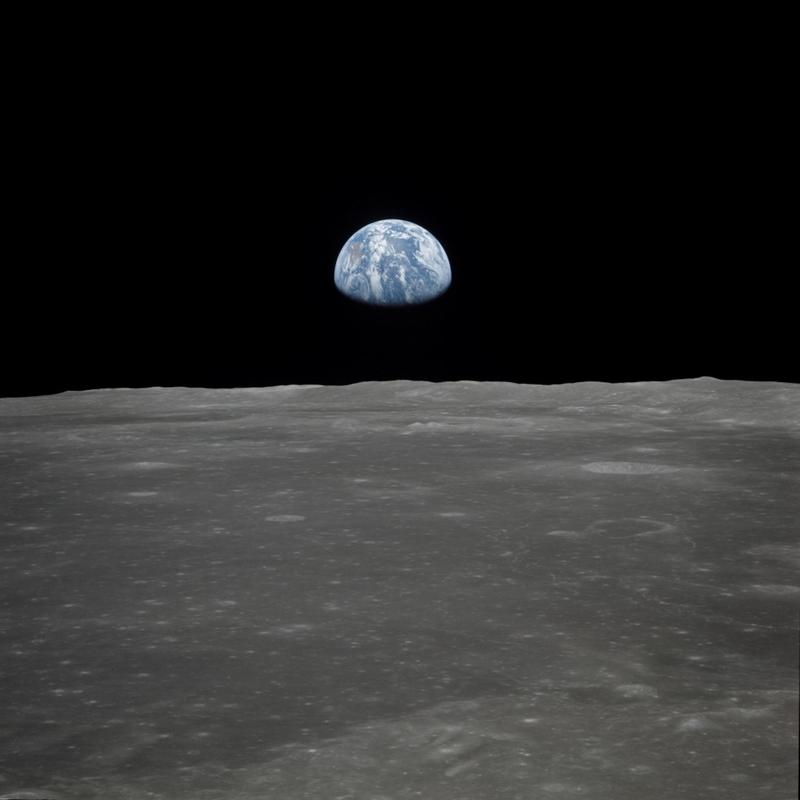 This July 1969 NASA file photo obtained July 16, 2019 shows a file view of Earth rising over the Moon's horizon taken from the Apollo 11 spacecraft.
(HO / NASA / AFP)
This July 1969 NASA file photo obtained July 16, 2019 shows a file view of Earth rising over the Moon's horizon taken from the Apollo 11 spacecraft.
(HO / NASA / AFP)
WASHINGTON - NASA on Friday set the stage for a global debate over the basic principles governing how humans will live and work on the moon, as it released the main tenets of an international pact for moon exploration called the Artemis Accords.
The accords seek to establish "safety zones" that would surround future moon bases to prevent what the US National Aeronautics and Space Administration called “harmful interference” from rival countries or companies operating in close proximity.
The accords seek to establish "safety zones" that would surround future moon bases to prevent what the US National Aeronautics and Space Administration called “harmful interference” from rival countries or companies operating in close proximity
They would also permit companies to own the lunar resources they mine, a crucial element in allowing NASA contractors to convert the moon’s water ice for rocket fuel or mine lunar minerals to construct landing pads.
READ MORE: Overview: China's major space programs in 2020
The accords are a key part of NASA’s effort to court allies around its plan to build a long-term presence on the lunar surface under its Artemis moon program.
“What we’re doing is we are implementing the Outer Space Treaty with the Artemis Accords,” NASA administrator Jim Bridenstine told Reuters, referring to a 1967 international pact that emphasizes that space should be used for peaceful rather than military uses.
The framework will be used as an incentive for nations to adhere to US norms of behavior in space, he added.
“It applies to low Earth orbit, it applies to the moon as well,” Bridenstine said. The accords also require countries to adopt standards of the United Nations Space Debris Mitigation Guidelines — which govern the prevention of hazardous space debris — and the Registration Convention, which would require countries to provide orbital details of their “space objects.”
The US Congress passed a law in 2015 allowing companies to own the resources they mine in outer space, but no such laws exist in the international community. The Artemis Accords, consistent with the Trump administration’s space policy, appear to clear the way for companies to mine the moon under international law and urge countries to enact similar national laws that would bind their private sector’s space operations.
ALSO READ: Yutu-2 discovers mysterious substance on moon's far side
“Why would private companies take the risk of going to mine resources if the legal situation was they could be kept from owning them?” Lori Garver, former deputy administrator of NASA, said to Reuters. “So anything this does to clear any of that up could really help advance progress in space development.”
Reuters reported earlier this month that the administration of US President Donald Trump was drawing up the Artemis Accords.
In response, Russia’s space agency chief Dmitry Rogozin criticized Washington for excluding Russia from early negotiations over the space exploration pact, drawing parallels with US foreign policy in the Middle East
In response, Russia’s space agency chief Dmitry Rogozin criticized Washington for excluding Russia from early negotiations over the space exploration pact, drawing parallels with US foreign policy in the Middle East.
“The principle of invasion is the same, whether it be the Moon or Iraq. The creation of a ‘coalition of the willing’ is initiated,” Rogozin wrote on Twitter. “Only Iraq or Afghanistan will come out of this.”
The safety zones — while intended to encourage coordination — have prompted questions on whether the accords align with the Outer Space Treaty, which states the moon and other celestial bodies are “not subject to national appropriation by claim of sovereignty, by means of use or occupation, or by any other means.”
The size of the safety zones would vary depending on the nature of the site they surround and would not constitute appropriation, Bridenstine said.
They would follow the principle that “basically says I’m gonna stay out of your way, you’re gonna stay out of my way, and we can all operate in this space,” he added.
ALSO READ: NASA spots lost Indian spacecraft on the moon
However, there is a question over who determines the sizes of the safety zones, said Ram Jakhu, associate professor at McGill University’s Institute of Air and Space Law in Canada. “Safety zones are necessary, but they can also be abused in a way that it may become appropriation.”
But Mike Gold, NASA’s associate administrator for international relations, told Reuters the language on moon mining shouldn’t worry other nations.
“The principles that are being put forward here is nothing that we believe any responsible spacefaring nation would disagree with,” he said.
“Via the Artemis Accords, we hope that the future will look a lot more like “Star Trek,” and a lot less like “Star Wars” by getting ahead of these issues,” Gold said.


